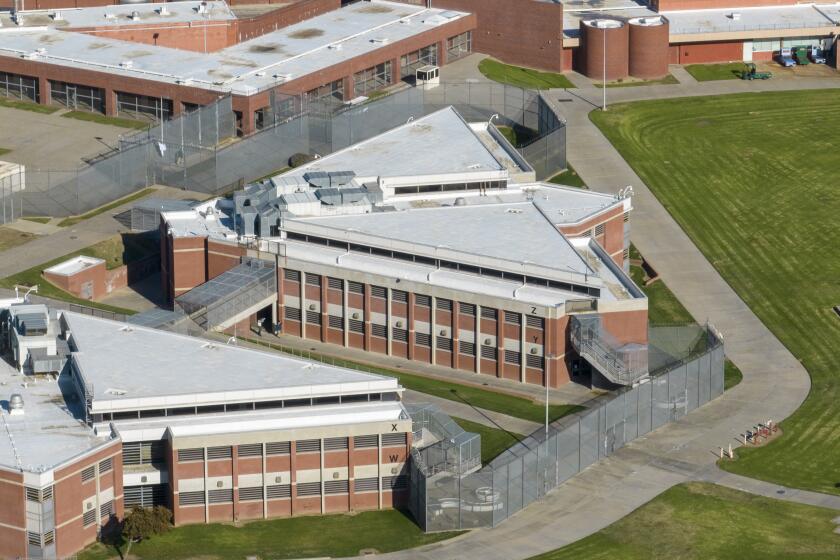L.A. County’s juvenile hall problem? It’s not the buildings

- Share via
No one should lament the likely closure this summer of Los Angeles County’s two remaining juvenile halls. Both the Barry J. Nidorf facility in Sylmar and Central Juvenile Hall near downtown have repeatedly failed inspections.
At the May 23 meeting of the Board of State and Community Corrections, both complexes are expected to be found out of compliance with minimum standards and therefore unsuitable to continue operating. They would be prohibited from housing juveniles beginning 60 days later (although a wing of Nidorf would continue to house people up to age 25 who formerly would have been in state custody).
Mismanagement has led to chaotic conditions at both detention centers, where rehabilitative and educational services are canceled and frightened personnel stay home. An 18-year-old died Tuesday at Nidorf of an apparent drug overdose. At least two other youths overdosed in April but survived. Two staff members were stabbed.
Many of the youth will likely be transferred to Los Padrinos, a juvenile hall in Downey that ceased operations in 2019 and was put to other uses.
The transfer would be an improvement — if the Probation Department’s problem were only with the buildings.
The reported death at a Los Angeles County detention center in Sylmar is further evidence of the county’s inability to responsibly run its juvenile halls.
But the problem with Nidorf and Central is not the physical structures. It’s the way they have been mismanaged, improperly staffed and ineptly supervised. The dysfunctional administrative culture currently plaguing the two doomed juvenile halls will simply follow the youths to Los Padrinos.
Before that facility closed in 2019, its conditions were a lot like Central and Nidorf, with unprepared and sometimes abusive (and sometimes truant) staff. Detained youth slept on floors in the overcrowded facility. State inspectors cited it for inadequate fire safety and medical and mental health care.
Hundreds of people allege they were sexually abused while in juvenile halls, including Los Padrinos. It’s not the buildings that molested them. It was, allegedly, the employees who worked there, enabled by managers who supervised them, operating under the culture of impunity that abetted them.
Anyone paying attention to the Probation Department’s recent history knows that its current problems aren’t new. For years there have been spates of employee arrests, failed inspections, threatened closures. It wasn’t the buildings.
Los Angeles County juvenile halls have been cited for unconstitutionally poor conditions for decades. It’s too late to save them.
The Board of Supervisors and other county officials focus too much on bricks and mortar as the causes and cures for social ills, perhaps because buildings are relatively easy to construct and demolish.
For example, they tried to reinvent juvenile probation by spending $48 million to renovate Camp Vernon Kilpatrick in Malibu to accommodate a new model of rehabilitative care, using intensive treatment in “home-like” living quarters instead of the military-style barracks that were standard in probation camps.
The new building was a smashing success. Barracks aren’t conducive to rehabilitation. Yet the project was still a dismal failure, undermined by union contracts that didn’t accommodate the new therapeutic program and a departmental culture that could not be torn down and rebuilt as easily as a probation camp.
Sometimes a building really is toxic. Men’s Central Jail, for example, harms everyone in it with a design that promotes fear and violence. The Board of Supervisors spent too many years arguing over what kind of building, rather than what kind of services, would replace it. If the same people with the same organizational culture operate a replacement, the problems will remain.
There are lessons in Martin Luther King Jr./Drew Medical Center, which was known for years as “Killer King” for deadly medical ineptitude, drug theft and other employee misconduct. The problem wasn’t the building. It was the institutional culture that mistreated patients inside.
The common denominator is the board’s micromanagement. Less meddling may well have been part of an effective prescription had it come forward in recent years.
Inspectors in 2007 found the medical center out of compliance with minimum standards and, like Nidorf and Central, unsuitable to continue operating.
The new Martin Luther King Jr. Community Hospital opened on the same campus in 2015. The hospital has a new operating structure that prevents much of the previous misconduct. It is a private nonprofit, not a county agency, and the workforce is not covered by county civil service rules, which were out of place at a hospital. The old hospital building now houses a well-regarded behavioral health center.
The point is not that the new MLK hospital is the right model for reinventing juvenile probation, but that buildings alone — shuttering them, reopening them — do not create or solve problems that are embedded in management, bad employee contracts and toxic organizational culture.
Those are the root of the county’s juvenile justice problems, and reopening the old detention center in Downey won’t solve them. Any lasting solution must break the Probation Department’s culture to put the rehabilitation of the juveniles ahead of the needs of the department managers, frontline officers and county supervisors. Until that happens, expect juveniles and staff to continue being injured and the Board of State and Community Corrections to intervene once more — this time, at Los Padrinos.
More to Read
A cure for the common opinion
Get thought-provoking perspectives with our weekly newsletter.
You may occasionally receive promotional content from the Los Angeles Times.











